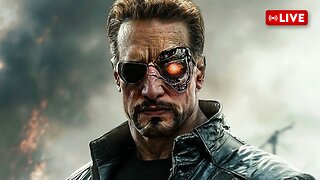Premium Only Content

Giant flounder surprisingly fails to mimic colour on lava rock in Galapagos Islands
Flounders are nature's true masters of disguise. Capable of rapidly changing the pigments in their skin to match their surroundings, they can transform their appearance in seconds. Visual cues inform the brain of the colours and patterns in their close environment and the brain signals the body to closely match these as quickly as possible. This is useful in avoiding predators, and also in ambushing prey.
The flounder is an awkward swimmer. It cannot rely on speed or agility to outrun larger fish or catch its food. It has evolved to lie on the bottom, waiting for opportunities. They begin their life swimming upright in a typical fish manner. One eye eventually migrates to the other side of the body so that it can lie on the bottom and use it's elongated eye structures like periscopes. This is an incredible adaptation that is unique to flounders.
These flounders were found in the waters of the Galapagos Islands. The large one in the final clip was found on a rock formation beside Cousin's Rock, a very remote dive site with strong current and stunning topography. The flounder had skillfully imitated the texture of the rock it was hiding on but it seemed to have struggled with colour-matching. The blue that it displayed was an obvious contrast to the pink and grey lava rock bottom.
The Galapagos Islands are unmatched in their beauty and diversity, drawing scuba divers from all over the world to see the animals that call them their home.
-
 2:08
2:08
WildCreatures
1 month ago $1.73 earnedScuba Diver is Surrounded by Gigantic Green Sea Turtles
3.65K5 -
 2:27:04
2:27:04
AirCondaTv Gaming
3 hours ago $2.69 earnedWar Thunder - Tankering Around for That 10 Bomb
15.5K3 -
 4:19:05
4:19:05
SpartakusLIVE
6 hours agoThe MACHINE locks in for 12-hour POWER stream
12.1K1 -
 1:58:40
1:58:40
Robert Gouveia
5 hours agoJ6 Coverup: Prosecute LIZ CHENEY; NY Judge REJECTS Immunity; Trump Breaks Gag?
50.7K28 -
 2:22:06
2:22:06
WeAreChange
3 hours agoPSYOP Spreads: Drones Shut Down Airport In New York!
39.5K13 -
 1:31:18
1:31:18
Redacted News
6 hours agoEMERGENCY! NATO AND CIA ASSASSINATE TOP RUSSIAN GENERAL, PUTIN VOWS IMMEDIATE RETALIATION | Redacted
183K240 -
 56:45
56:45
VSiNLive
5 hours ago $4.64 earnedFollow the Money with Mitch Moss & Pauly Howard | Hour 1
51.6K2 -
 52:44
52:44
Candace Show Podcast
5 hours agoMy Conversation with Only Fans Model Lilly Phillips | Candace Ep 122
63K239 -
 UPCOMING
UPCOMING
tacetmort3m
5 hours ago🔴 LIVE - RELIC HUNTING CONTINUES - INDIANA JONES AND THE GREAT CIRCLE - PART 5
30.2K -
 26:52
26:52
Silver Dragons
4 hours agoCoin Appraisal GONE WRONG - Can I Finally Fool the Coin Experts?
23.5K2